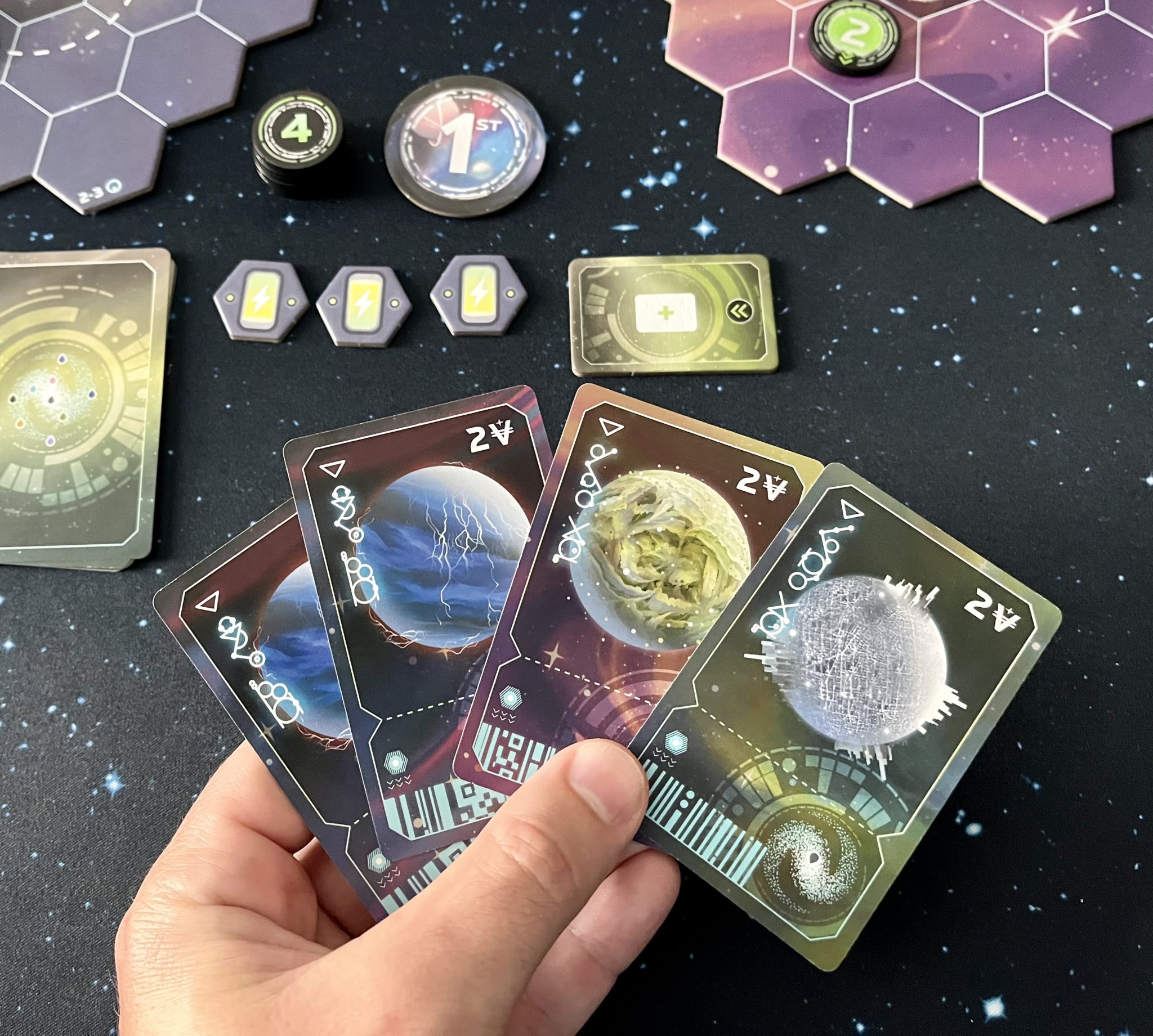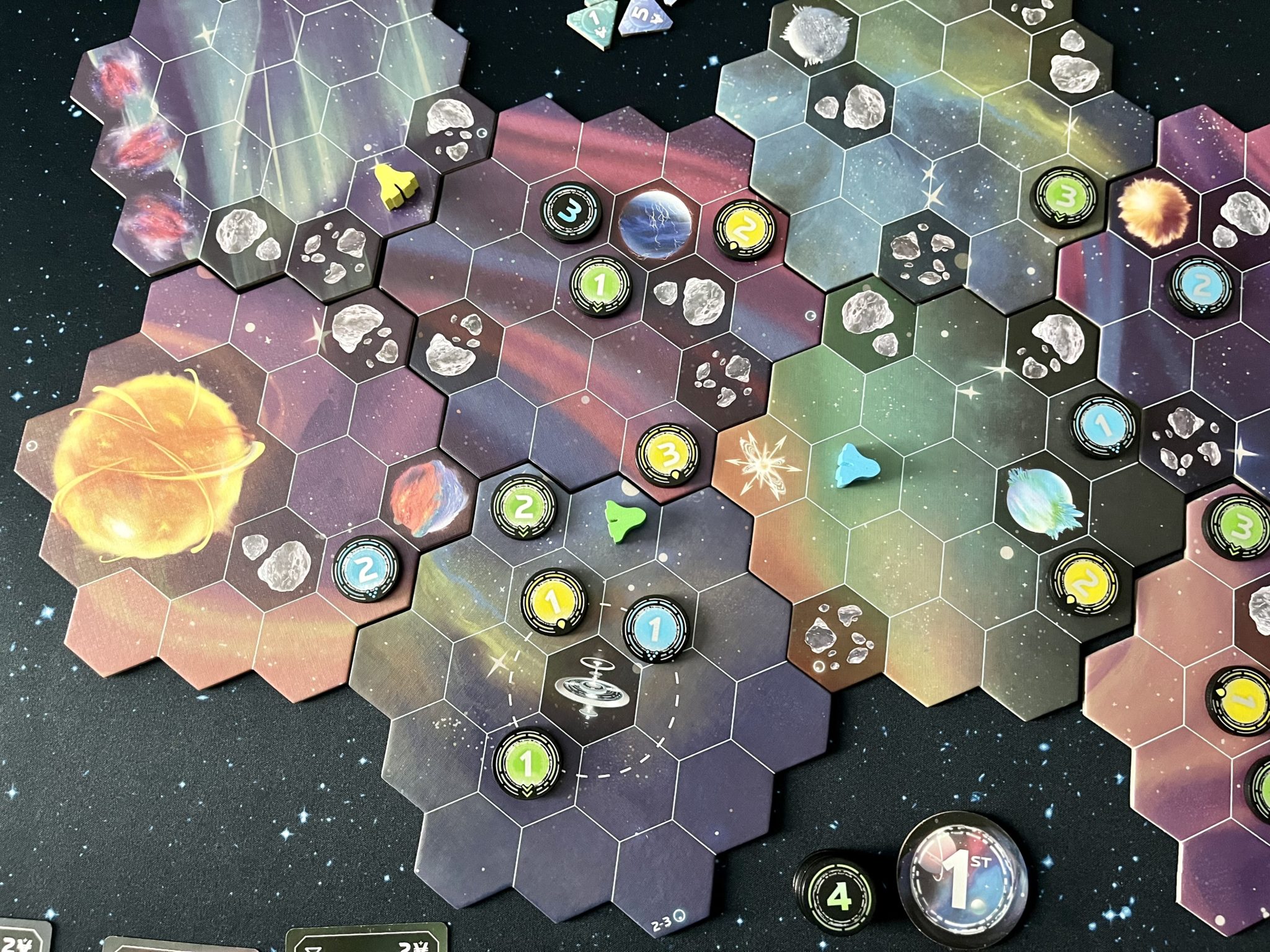Wormholes have been invented and are being used in a peaceful galaxy to help transport passengers from planet to planet. A ship will enter one end of the wormhole and immediately be warped to another point. This technology tremendously helps the commerce of travel throughout the galaxy. Players will place out wormholes, and transport patients to gain points. The game is designed by Peter McPherson, and is published by Alderac Entertainment Group (AEG), which is known for making some great games. We have been able to review Whirling Witchcraft, Ten, Cascadia, and Cat Lady. AEG has some proven games and Wormholes just adds to the list.

What’s in the Box?
- 10 Space boards
- 100 Passenger cards
- 5 Ship tokens
- 50 Wormhole tokens
- 15 Energy tokens
- 5 Pickup tokens
- 1 First player token
- 10 Exploration tokens
- 46 Point tokens
- 1 Space randomizer token
- 5 Reference cards
- 3 Round countdown tokens
- 1 Planets connected token

How’s it Play?
All players control a space ship represented by a ship token on the map. The map is formed by randomly placing out space boards in a pattern. Players have 3 energy to perform actions during their turn. Some actions cost energy but others, depending on the circumstances of the board, are free. As players use their actions, they will also be placing out wormholes. Wormholes lets players warp from one of its tokens to its pair, which can be across the entire board. So with all these wormholes forming on the map as the game progresses, traveling long distances becomes easier.
Players continue the game until each planet has a wormhole placed next to it, at that point players have 3 more turns until the game ends. Players are playing the game to set themselves up to gain the most points before the game ends. Points are scored in the following ways: by placing wormholes next to planets without a wormhole next to it, when other players use another player’s wormhole, when dropping off passengers to a specific planet, and when dropping off passengers to more than 5 different planets.

Now to the specifics of gameplay. The game board is formed with hex boards that are randomly placed out in a specific orientation. Each player has 3 energy tokens that they use to take actions with. There is a list of actions that cost energy, and a list of free actions that don’t cost any energy to perform.
Actions that cost energy:
1. Moving – move your ship to an adjacent hex space. You cannot move onto or through spaces with a dark background, these are obstacles. But players can share spaces and also move onto spaces with wormhole tokens on them. Energy is use when moving between adjacent spaces and not when moving through wormholes.
2. Picking up passengers – Once per turn when adjacent to a planet or the space station, a player can pick up passengers. First, the player can choose to discard any number of passenger cards currently in their hand. When discarded the cards are placed in the space station docks which as laid out face up making stacks of each planet.

a. Picking up from a planet – The player draws cards from the passenger deck until they have 4 cards total in their hand. If a drawn card matches the adjacent planet, they must discard it in the space station dock and draw a new card.
b. Picking up from the space station – After discarding any cards, the player takes face up cards in the space station dock from up to 2 different planets until they have 4 cards in their hand. Cards are never drawn from the deck when picking up passengers from the space station.
After picking up passengers, the player then flips their pickup token to the inactive side to show they have already picked up passengers this turn.

Actions that are free that cost no energy:
1. Placing wormhole tokens – Place a wormhole token on or adjacent to their ship’s space. Wormholes can be placed on any blank space without a wormhole token on it already. The wormhole token placed needs to be the one on top of their stack which will either complete a wormhole pair or start a new one. Wormholes cannot be placed adjacent to the same planet or space station if that player already has a wormhole placed by that planet or space station.
2. Warping through wormholes – It costs an energy to move onto a wormhole from an adjacent space, but not to travel from from one wormhole to the matching wormhole or one with the same color and number. If a player uses another player’s wormhole, the owner of the wormhole collects a 1 point token. A player can warp through as many wormholes as they would like but needs to perform an action in-between each warp. Players that use their own wormhole do not take a 1 point token, but are free to warp between them.
3. Dropping off Passengers – Whenever adjacent to a planet, a player can drop off all passengers by placing the matching planet card from their hand forming their own stack of dropped off passengers near their player area. Each dropped off passenger is worth 2 points at the end of the game. The galactic tour bonus will award points at the end of the game. Each player can earn 3 points for every different planet beyond the first 5 that they drop patients off at.

4. Use a map feature – Some areas of the board change the rules a little bit. Kind of like space.
- Orbits – The orbit around the space station allows players to move from any space in the orbit to any other space in the same orbit for 1 energy regardless of the distance.
- Big Ring Planet – The Big Ring Planet allows a player to place any number of wormhole tokens adjacent to this planet.
- Nebulae – The nebulae spaces allow players to move to any adjacent space without spending energy. It costs energy to move into the nebulae, but not moving from it.
- Wild wormholes – Wild wormholes have a number corresponding to a pair of that player’s wormholes. A player can warp from the wild wormhole to any of their personal wormholes of the same number. And they can warp to the wild wormhole from their own wormholes as well.
- Photon Cannon – The Photon Cannon allows for a free action to launch that player as many spaces in a straight line of adjacent hexes in any direction starting at the photon cannon.
- Black Hole – The Black Hole causes a player who immediately enters it to reveal the top card of the passenger deck and place their ship on any space adjacent to that planet shown on that card.
Players can take advantage of all the free actions they can to perform or want to perform. After using their 3 energy, the next player takes their turn and the earlier player resets their energy tokens by flipping them back over, and also their pickup token if used.

After all planets have a wormhole placed adjacent to it, there are 3 rounds left in the game. After that, players count up their points from exploration tokens, point tokens from other players using another player’s wormholes, dropped off passenger cards, and from the galactic tour bonus if applicable. The player with the most points wins the game.
The Verdict
I absolutely love this game mainly because the game is very easy to understand, yet the management of how you use your actions is huge. You want to set up your wormholes so that you can travel the board more easily, but also allow other players to use your wormholes so you can gain points from them doing so.
Besides your wormhole placement being a huge deal for this game, so is dropping off passengers. You need to make sure you have passengers in your hand so that when you make a trip, its actually worth doing it. Maybe at the beginning of the game dropping off one passenger card to a close planet is fine because you are also placing out your wormholes, and being the first to place your wormhole next to that planet, but later in the game, you need to stack those passenger cards the best you can. Returning back to the space station to be able to pick up and choose specific cards to planets should be a focus. This only works after players pick up passengers and discard passenger cards when visiting other planets.

Wormholes is pretty basic, but the added map features that let you launch across the board, or move further without spending energy changes how the game feels so you don’t get bored with doing the same thing.
The board is different every time you play, and can change how the game progresses. But with those changes, you still know how to play the game and can get through a game in 30 minutes after all players know what they are doing. We learned after our first couple plays that you need to place down more wormholes than you think. They are free actions, so it doesn’t change too much of the game, but will really help with movement around the board.
Overall, Wormholes is a nice quick game where points are determined by only 4 things, and although things can get strategic, the game is pretty straight forward. This will definitely get to my table a lot more.
You can grab a copy of Wormholes at the AEG shop, Amazon, or your FLGS!
Images via Alderac Entertainment Group (AEG)
Have strong thoughts about this piece you need to share? Or maybe there’s something else on your mind you’re wanting to talk about with fellow Fandomentals? Head on over to our Community server to join in the conversation!

